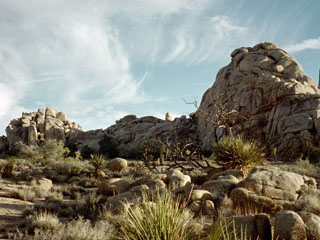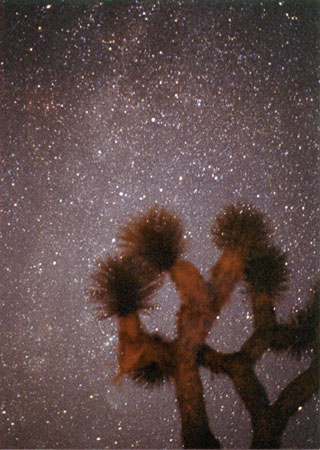| Old Town Sidewalk Astronomers | |
Observing Report from Joshua TreeFebruary 5, 2005Jane Houston Jones |

Mojo and I attended our first Joshua Tree National Park public star party as members of the Yucca Valley based Andromeda Society on Saturday, February 5, 2005.
Our main objective was to observe Saturn and the moons of Saturn through our 7-inch refractor. A few of the society members stopped by for a look, and, yes Saturn looked stunning. The Cassini and Encke divisions were prominent. Each of Saturn's three main rings were distinct in color. The outer A-ring was darkest, the broad B-ring was brightest, and the inner crepe or C-ring was subtle, nearly invisible except where the planet's disk lit the faint ring material — here the crepe ring was easy to see against the disk of Saturn. The dark butterscotch colored belts and bright honey colored zones alternated and the color gradually darkened closer to the two south temperate belts and the south polar belt region, which was very dark, almost molasses color. Hmmm. Butterscotch, honey and molasses. :-) The south equatorial belt of Saturn showed wind blown ripples and notches. I sometimes sketch Saturn, but it was just too cold to take off my gloves and hand warmers to hold the pencils. Here is a nice map showing all the features I mention, plus many more which I did not mention.
The next project on my clipboard was to observe Saturn's moon Iapetus. Iapetus is brighter at western elongation and fainter at eastern elongation, which makes it a great repeatable observing project. Iapetus reached its brightest western elongation February 4th, and I have been watching it, and comparing its brightness for the past several weeks. I printed some star charts for Saturday night, and noted the magnitude of all the adjacent stars to help me confirm its magnitude, which was a fraction more than 10. There were nearby 9th to 11th magnitude stars to compare against Iapetus.
Not everyone who takes a look at Saturn observes Iapetus, although it is Saturn's third largest moon. It is easier to locate near Saturn at both inferior and superior conjunction, when it is closest to the planet and visible to the north and south of the planet, respectively. But its 79 day orbit takes Iapetus far outside the usual planetary eyepiece view. In fact, Iapetus is 3 times further from Saturn than Titan, or 12 ring diameters from Saturn when it shines the brightest.

The magnitude of Iapetus varies from 10.1 at western elongation to 11.9 at eastern elongation. We have known for a long time that the leading side of Iapetus is dark as coal, while the trailing side is bright as snow. We are looking at the bright trailing side of tidally locked Iapetus when it is at western elongation (this week), and we are looking at the dark leading side of the moon at eastern elongation (March 15). Why this is so is still under debate, as it has been for the past 334 years. Cassini discovered Iapetus in 1671 and he made the note that he could only see Iapetus on one side of Saturn and not on the other side. The dark area of Iapetus is called Cassini Regio, and may be dark because the leading side of Iapetus collides with or alters dust from the moon Phoebe. Stay tuned as the Cassini instrument teams study the Iapetus data, and release their findings. Cassini will have one more flyby of Iapetus in September 2007. This year, on January 1, Cassini flew by Iapetus at a distance of 40,000 miles. The 2007 flyby will be from a distance of 763 miles. Want images?
Now it was time to move from the solar system into the rest of our Milky Way galaxy. Oh, we had good long looks at Comet Machholz first. In the dark sky, the tail was very long, and the comet was bright, still a naked eye object. We probably had a couple dozen members of the public stop by for looks at Saturn and the comet, and later I did a "top 20" type Messier show for some other interested visitors. By 8:30 p.m. they were all frozen and heading to warm cars or sleeping bags.
My next project was from Sky and Telescope magazine. In the February 2005 issue, Jim Kaler weaves a story of stellar birth, life and death in Taurus and Auriga. When we look at this part of the Milky Way galaxy, we are looking out through the thinnest part of the galactic disk, through a large dusty interstellar cloud, the Taurus-Auriga star forming region.
The article, on page 90 is called "Through Taurus to the Anticenter" and just reading the article gives you a firm grasp of stellar evolution (Jim's specialty) all nicely packaged in an observing project. I love it when that happens. I always learn something. I won't detail every object, but there are 17 open clusters and 18 variable stars in the project. My favorite open clusters were a couple pairs of clusters, NGC 1807 and 1817, which touch each other, and NGC 1750 and 1758, which are separated in our line of sight by 500 light years. Amazing! Many of the objects are favorite Messiers like M35, the Pleiades, Hyades and the three "M"s in Auriga, M36, 37 and 38. An easy and quick starhop, requiring nothing more than the magazine star charts and a red flashlight, exactly my kind of low tech observing tools. I used my 12.5-inch reflector for the clusters.
For the variable stars, I moved back to the refractor. Just taking a one-time look at these variables means glimpsing at wild places in our own Milky Way neighborhood. Some are eclipsing binaries, and the remainder tell the story of stellar evolution from newly forming protostars to main sequence hydrogen fusing stars like our sun to old giants that have quit fusing helium, on to carbon stars. Just observing one moment in one day in the life of these wild things was exhilarating.
Well, that took about 2 hours, and did I mention it was really cold? At midnight we packed up and drove back home. We both had a great time, and look forward to next month. A highlight for me was having a good look at Canopus, known to ancient Arabs as the ship of the desert. A perfect star to see from Joshua Tree National Park.
Date February 5, 2005
Location: Hidden Valley picnic area, Joshua Tree National Park
Altitude: 4,208 feet
Latitude: 34°N
Longitude: 116°W
Seeing: good 4/5 in parts of the sky, limiting magnitude using area 16 Alpha Cvn, Epsilon and Eta UMa and area 8 Alpha, Beta, Zeta Tau LM 6.3
Equipment:
LITEBOX reflector: f/5.75 12.5-inch at 96X with 19 Panoptic and 202x with 9mm Nagler
F/9 Astro Physics 180EDT refractor, up to 280x 19mm Panoptic eyepiece, and some Zeiss Abbes at higher power
Jane Houston Jones
JPL Cassini Outreach
jane.h.jones@jpl.nasa.gov
Copyright © 2005 Jane Houston Jones
Last updated: